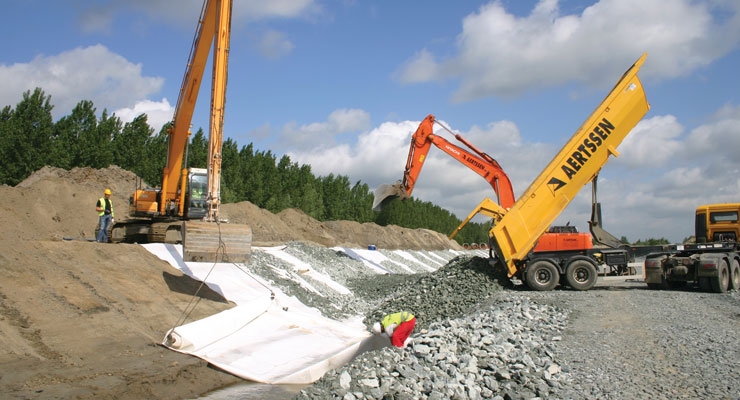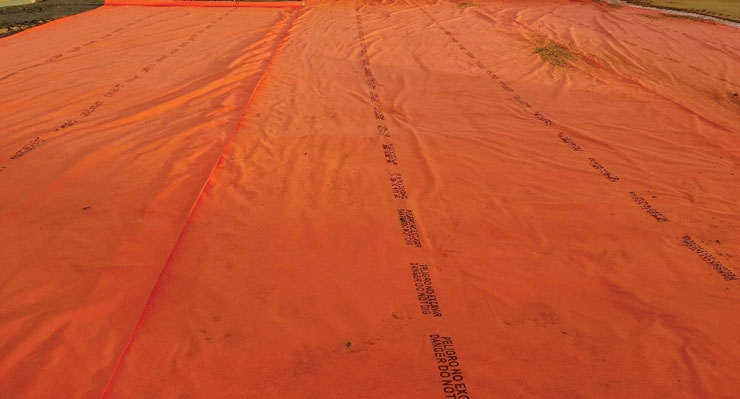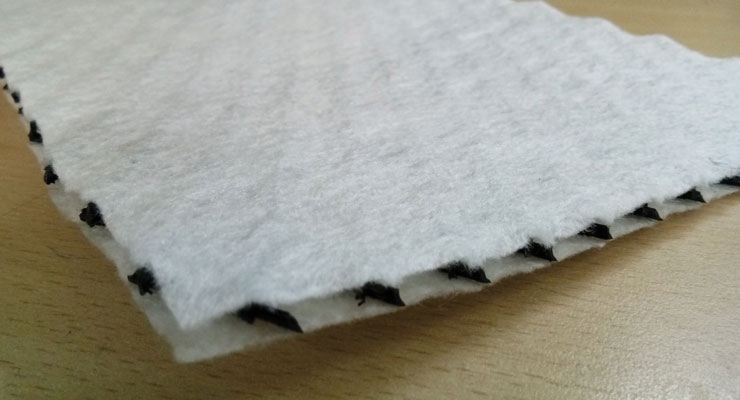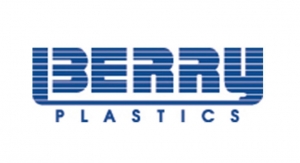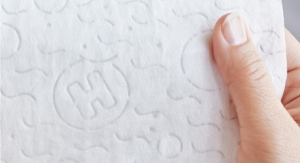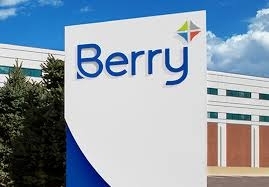Tara Olivo, Associate Editor08.09.18
Various infrastructure projects, along with increasing acceptance of nonwoven-based geotextiles, are some of the factors helping drive growth for this market around the globe. With nonwovens, the result is consistent performance and quality, and products that retain their strength over decades.
INDA, the association of the nonwoven fabrics industry, tracked the geotextiles market in a report, the North American Nonwovens Industry Outlook, 2016-2021. In its reporting of the geosynthetics category, INDA divides geosynthetics into two markets: civil engineering and agriculture. The civil engineering products are primarily those made from geotextiles, while the agriculture products tend to be of a similar nature and nonwoven manufacturing process as geotextiles, the association says.
According to data in the report, the geosynthetics markets increased 2% annually in tonnage from 2011 through to 2016 and 1.8% annually in square meters.
Both categories have positive growth through the forecast period, with the civil engineering market having the potential for a significant upside. Overall, the geosynthetics market is expected to improve slightly, increasing 2.2% annually in square meters and 2.4% annually in tonnes, according to the report.
INDA found that public spending for projects involving geosynthetics in North America was mostly subdued from 2011 through 2016—with spending only increasing .05% annually during that period. Although, the more geosynthetic intensive using categories showed solid growth as highway and street spending increased 2.8% annually and transportation related spending increased 3%, according to the report. Spending for private nonresidential construction from 2011 through 2016 was 8%, driven by spending in the private power area as the gas and oil businesses continued to add new hydraulic fracturing drilling sites and associated infrastructure for those sites.
The report states that nonwoven geosynthetics used in non-highway and street applications is the largest category, with the North America civil engineering markets using 58% of the total square meters consumed and representing 74% of the total tonnes.
Given limited public spending, nonwoven geotextiles for road applications increased 0.7% annually, in both square meters and tonnes, between 2011 and 2016. The growth rate for geotextiles for highway and street applications is forecast to pick up through the forecast period, to 2.1% annually.
Berry Global Brings Terram to North America
A veteran in the market, Typar Geosynthetics, which became part of Berry Global during its 2015 acquisition of Avintiv, is one of the world’s largest and leading suppliers of high-performance specialty nonwoven fabrics. According to Keith Misukanis, director of sales and marketing, North America, Typar has products that have been in the ground for 45 years—and have retained over 70% of their strength.
Typar is made using spunbond/heat-bonded technologies and is built with continuous strands of polypropylene. In other regions of the world, including Europe and the Middle East, Berry offers Terram, a polyethylene over polypropylene continuous process. Following recent qualifications from U.S. transportation groups such as the National Transportation Product Evaluation Program (NTPEP) and American Association of State Highway and Transportation Officials (AASHTO), Terram will be available to customers in North America.
Products from both brands are used for separation, filtration/drainage, ground stabilization, protection, erosion control, and warning/detection applications for highways, railways, grass/ground, landfill, coastal and waterways, pipelines, foundations and other structures.
“Nonwovens make very repeatable processes,” says Misukanis. “They allow water to flow, they have longevity within ground areas, and from a supply point of view, they’re efficient to move.”
Nonwovens are continually replacing aggregate and fill materials, and they help the durability of the materials, so the making of landfills, walls, roads, and other structures will last a lot longer than what was possible without geosynthetics, he adds.
As geosynthetics become more and more qualified, with more experiments and research and development being conducted, the longer roads of the future will last. “[Many of these] products were used when roads were being designed to last for 10-20 years,” Misukanis explains. “When we get better geosynthetics that are involved in roads, we could potentially see roadways that are able to last for 40 years—with less potholes, less movement, and they will be more solid over that entire time, which saves money.”
Among Berry’s innovations in the geotextiles sector are Typar Geocells, which utilize the strength and permeability of geotextile fabric to create a three-dimensional confinement system. The cellular design allows for configuration and adaptability to a variety of terrains. Geocells can be used in, for example, flood protection or even military protection, where the barrier system provides personnel and infrastructure protection from small arms fire right up to VBIEDs and artillery.
According to Misukanis, Berry is one of the few companies that is providing a geotextile version of a geocell. “Most of the time they are straight HDPE sheet material that they have to punch holes in and they have tremendous weight. Using a geotextile, our material is fully permeable along hills, so it works well in water flow applications,” he explains.
The need for cleaner water has led to the development of large geocells that are purifying water off of these sites. “By incorporating the larger geocells, there is a reduction in the turbidity of site runoff as opposed to sock materials that can be found on sites or the silt fence. Often times, those types of products basically become a dam and have little to do with cleaning of the water,” Misukanis says. “What we’ve done with our Typar Geocells is they work to clean the water. Several jurisdictions are pushing for this instead of just putting a silt fence to control since they actually want to clean the water and remove turbidity.”
Another recent development from Berry is its Salt Barrier Geocomposite. This product was developed to preserve the viability of the upper layers of soil for use in landscaping and planting projects. Traditionally, in regions with saline groundwater, planting is difficult due to the inability to restrict the rise of saline water into the plant roots. With the salt barrier, saline water is drained and only nonsaline water reaches the plant roots.
Meanwhile, Berry’s Rail Geosynthetics, which have been popular in Europe, are now approved for the U.S. One of its latest products is the Terram Hydrotex Trackbed Separator for Clay Pumping. The nonwoven composite consists of a central filter media thermally bonded to two opposing needlepunched nonwovens (robust filters) to create a geocomposite with sufficient strength and protection to be durable to the abrasion and point loading of ballast. The traditional use of a sand blanket in railway trackbed uses a sub-ballast and/or a graded-sand layer to prevent the upward movement of fine sub-grade particles, while allowing effective drainage and dissipation of water pressure. Terram Hydrotex offers this solution in one geocomposite. “This helps to stabilize rail beds by a very specific application of materials,” Misukanis says.
Low & Bonar is Optimistic
Low & Bonar offers a range of needlepunched nonwoven geotextiles including both thermally treated and non-treated material in black and natural white color. All geotextiles are made from virgin polypropylene resin and are used in several applications including separation, filtration, drainage, protection and erosion control.
According to Sebastien Verbrugghe, Low & Bonar’s regional sales manager Civil Engineering Solutions for Southern Europe, Africa, LATAM & APAC, these functions are key for infrastructures constructions (road, railway, airport, harbor, tunnel), hydraulics and coastal works (marine protection, land reclamation, canals, ponds) and environmental projects (landfill, windmills, mining, dewatering).
There are many benefits of using geosynthetics over traditional solutions for building and civil engineering projects, according to Verbrugghe. “Traditional solutions usually involve natural material. By using geosynthetics, you benefit from manufactured products with consistent performance, quality controlled. Furthermore, solutions are tailor made and provide low carbon footprint by requesting less lands, lower needs in transports and lower energy consumption,” he explains.
Driving demand in this market are public investments in infrastructures, as well as industries such as mining and waste management. The advantages of geosynthetics over traditional materials are becoming more and more valued by designers, leading to higher use of geotextiles, according to Kenny De Wolf, product manager Civil Engineering at Low & Bonar.
In particular, the company expects to see strong market growth in the Asia Pacific, Latin America and NAFTA regions, while Europe is expected to remain steady, but with some higher growth in the Eastern part of the continent. Africa, on the other hand, remains unpredictable, according to Verbrugghe.
“These geographical differences in investments will lead to regions where the demand surpasses the supply, whereas other regions might be faced with a supply that surpasses the demand,” De Wolf explains.
Low & Bonar has responded to market growth around the world by investing in a new line as well as adding some other new capabilities. At the end of 2016, the company finalized new line implementation at its Hungarian production plant. “This state-of-the-art line provides the most up-to-date technologies in terms of needlepunching,” Verbrugghe says. “This new tool provides to Low & Bonar opportunities in term of volumes, but also applications as the new line allows productions of nonwovens with weight up to 1500 g/sqm and width up to 6.50 m.”
Low & Bonar has also extended its capabilities at its Belgian plant to improve its offering in custom made and semi-finished product, next to its standard geotextile range, De Wolf adds.
Propex Offers a Range of Nonwoven Geotextiles
Chattanooga, TN-based Propex continues to grow its line of nonwoven geotextiles under its GeoSolutions portfolio.
Its Geotex Nonwovens product line is engineered to support roadways and infrastructure projects. Within this line are products that provide separation and stabilization, subsurface drainage, filtration and cushioning. “Using nonwoven geotextiles in transportation projects will save cost and installation time while increasing the overall service life of the project and decreasing future maintenance costs,” says Noah Nichols, executive director – Marketing & Product Development, Propex.
One of the most common uses of Geotex is to provide separation and stabilization for paved an unpaved roads, which is done by placing the geotextile between the subgrade soil and base aggregate, according to Nichols. “When a nonwoven geotextile is used to stabilize a road, less aggregate is required during construction, saving up to $50,000 per lane mile,” he adds. “It can also double the road’s performance life and cut back on future maintenance for issues like cracks, rutting and potholes.”
Another innovation from Propex is Petromat, a geotextile paving fabric that provides protection against moisture and reflective cracking while increasing stress absorption beneath any flexible pavement.
Meanwhile, Reflectex is a solar reflective concrete pavement interlayer geotextile that reduces surface temperature during installation and provides stress absorption resulting in an 8-10% reduction of early cracking.
On the new product front, the company recently launched Geotex DND Orange, a demarcation fabric that signals excavators from further digging in areas that may have hazards such as buried contaminants, piping, cables or other dangers. The fabric is bright orange and has Danger Do Not Dig/Peligor No Excavar printed on it. “While demarcation fabrics are not new, the practice of printing directly on the fabric is new,” Nichols points out. “Past installations required printed tape to be applied to the geotextile, which added extra cost and time.”
In the next few months, the company plans to release new nonwoven technologies specific to the paving industry.
Several factors are helping drive growth in the North American market, according to Nichols. First, in the U.S., the passing of the Federal Highway Administration’s Fixing America’s Surface Transportation (FAST) Act in 2015 increased the Federal budget by 20% annually for infrastructure spending, launching widespread roadway improvement initiatives throughout the U.S. “In addition to increased funding, the FAST Act encourages the use of durable, resilient and sustainable materials and practices, including the use of geosynthetics and other innovative technologies,” he says.
Other positive factors helping drive growth, he adds, are increased construction spending, new regulations for the disposal of coal ash, and the revitalization of oil and gas produced in North America, specifically fracking in the U.S.
TechFab India Offers New Composite for Drainage
Founded in 2003, TechFab India manufactures a wide range of geosynthetic products at facilities in Silvassa and Daman.
Among its nonwoven-based geotextile products are staple fiber needlepunched nonwovens under its TechGeo line, which include its N-Range with tensile strength 6.5 kN/m to 20.5 kN/m, and the H-Range with tensile strength 24 kN/m to 75 kN/m, where TechFab India has an in-house line of PP staple fiber production, which ensures the consistent quality of the final products. These geotextiles are used for separation, filtration, drainage and other applications. TechFab India also offers Geobags with nonwovens for erosion protection and river bank/coastal protection work.
Its latest product, a drainage composite called TechDrain used for drainage in pavement and retaining structures, was launched in the last year. It is a combination of a geonet and nonwoven geotextile. The geotextile used here is either needlepunched or a thermally bonded nonwoven geotextile, and the net/core used in between the two geotextiles or the one side geotextile is made up of high density polyethylene (HDPE).
“When a geotextile is used on one or both sides of a geonet, the separation and filtration functions are always satisfied, but the drainage function is vastly improved in comparison to only geotextiles,” says Manish Barot, head – Technical Sales & Business Development, TechFab India.
In general, nonwoven fabrics are a dynamic, value-added alternative to traditional materials. “With nonwoven technology, fabrics can be designed to take on an array of characteristics that other materials simply cannot match,” he adds.
These advantages include greater strength per basis weight than competing fabrics, high levels of uniformity, form holding in the Z direction, high tear and tensile strength, dimensional stability, consistency in high temperature applications, application-specific engineering and ability to form composites for advanced performance, Barot says.
In India, infrastructure developments are at their highest peak at present since the country’s new government came in power, he says. As such, major projects are underway for highways, coastal highways, railways, port development, coastal and river training works, and solid waste management.
“During such developments, so many problems are also associated with the infrastructure constructions such as alignment of roads and railways through problematic ground conditions, scarcity of natural resources (stone, sands, gravel, etc.), and drainage issues,” Barot says.
In his opinion, advanced applications need to be adopted by government authorities. “As a result, the last couple of years have seen various geosynthetic applications grow slowly, but will continue to grow day by day. The prominent manufacturing industries—like us—are putting in a lot of effort to educate the client, consultants and contractors, giving them examples and showing case studies from developed countries like the U.S., U.K., and in Europe where these applications are used and still in practice. We believe that this will definitely give good results in the future for growth of the geosynthetic industry in India.”
While the company does expect stronger growth in the future, India’s installed manufacturing capacity is in excess compared to the demand. “Until the regulatory authorities make this mandatory to use in infrastructure development, there will remain significant overcapacity of production,” he explains.
And, in spite of the Indian government authorities trying to convey the advantages of these products, the sales of virgin polymer nonwoven geotextiles are next to nil in India, he adds. “The complete market has been taken by recycled polyester nonwoven fabrics, which are sold in weight basis and not on performance basis. This has happened due to weak implementation of specification standards as prescribed in the tenders and large-scale corruption by unscrupulous manufacturers in order to get orders,” he stresses.
TenCate Geosynthetics Americas Sees Growth
TenCate Geosynthetics Americas manufactures needlepunched nonwoven geotextiles in Pendergrass, GA. The majority of the nonwovens produced are used in civil and environmental engineering applications, which require one or more of these functions: separation between dissimilar soil/aggregate materials, filtration and drainage.
TenCate Geosynthetics Americas’ geotextiles used for separation are used in between subgrade soils and stone base in paved and unpaved roads, rail ballast and other working platforms.“There is an engineering adage: ‘If you place 10 lbs. of stone on 10 lbs. of mud, you’ll end up with 20 lbs. of mud,’” says Rene Laprade, technical marketing manager, TenCate Geosynthetics Americas. “Nonwoven geotextiles prevent this intermixing of dissimilar materials from taking place.”
Filtration, meanwhile, involves the movement of liquid through the geotextile itself while, at the same time, retaining the soil on its upstream side, Laprade explains. “This prevents soil loss and piping that could destabilize the structure.”
The company’s nonwoven geotextiles for drainage are placed in such a way as to transmit liquid within the plane of their structure to provide a drainage function.
“Nonwoven geotextiles allow civil and environmental projects to be constructed far more economically due to the reduced use of valuable natural resources (sand, granular materials). Significant economies in materials and construction time can be achieved with the proper use of these synthetic materials,” Laprade says.
TenCate continuously invests in the latest technology to produce high quality products. As a result, the company recently completed a major upgrade to expand capacity.
From TenCate’s point of view, the global nonwoven geosynthetics market continues to grow largely due to increased understanding of the benefits these products offer coupled with rebounding global economies that are generating more tax revenues leading to more transportation related spending.
Recent restructuring in the domestic market has caused a tightening on the supply side, according to Todd Anderson, VP of Sales & Marketing, but major manufacturers, like TenCate, are investing millions in this growing market.
INDA, the association of the nonwoven fabrics industry, tracked the geotextiles market in a report, the North American Nonwovens Industry Outlook, 2016-2021. In its reporting of the geosynthetics category, INDA divides geosynthetics into two markets: civil engineering and agriculture. The civil engineering products are primarily those made from geotextiles, while the agriculture products tend to be of a similar nature and nonwoven manufacturing process as geotextiles, the association says.
According to data in the report, the geosynthetics markets increased 2% annually in tonnage from 2011 through to 2016 and 1.8% annually in square meters.
Both categories have positive growth through the forecast period, with the civil engineering market having the potential for a significant upside. Overall, the geosynthetics market is expected to improve slightly, increasing 2.2% annually in square meters and 2.4% annually in tonnes, according to the report.
INDA found that public spending for projects involving geosynthetics in North America was mostly subdued from 2011 through 2016—with spending only increasing .05% annually during that period. Although, the more geosynthetic intensive using categories showed solid growth as highway and street spending increased 2.8% annually and transportation related spending increased 3%, according to the report. Spending for private nonresidential construction from 2011 through 2016 was 8%, driven by spending in the private power area as the gas and oil businesses continued to add new hydraulic fracturing drilling sites and associated infrastructure for those sites.
The report states that nonwoven geosynthetics used in non-highway and street applications is the largest category, with the North America civil engineering markets using 58% of the total square meters consumed and representing 74% of the total tonnes.
Given limited public spending, nonwoven geotextiles for road applications increased 0.7% annually, in both square meters and tonnes, between 2011 and 2016. The growth rate for geotextiles for highway and street applications is forecast to pick up through the forecast period, to 2.1% annually.
Berry Global Brings Terram to North America
A veteran in the market, Typar Geosynthetics, which became part of Berry Global during its 2015 acquisition of Avintiv, is one of the world’s largest and leading suppliers of high-performance specialty nonwoven fabrics. According to Keith Misukanis, director of sales and marketing, North America, Typar has products that have been in the ground for 45 years—and have retained over 70% of their strength.
Typar is made using spunbond/heat-bonded technologies and is built with continuous strands of polypropylene. In other regions of the world, including Europe and the Middle East, Berry offers Terram, a polyethylene over polypropylene continuous process. Following recent qualifications from U.S. transportation groups such as the National Transportation Product Evaluation Program (NTPEP) and American Association of State Highway and Transportation Officials (AASHTO), Terram will be available to customers in North America.
Products from both brands are used for separation, filtration/drainage, ground stabilization, protection, erosion control, and warning/detection applications for highways, railways, grass/ground, landfill, coastal and waterways, pipelines, foundations and other structures.
“Nonwovens make very repeatable processes,” says Misukanis. “They allow water to flow, they have longevity within ground areas, and from a supply point of view, they’re efficient to move.”
Nonwovens are continually replacing aggregate and fill materials, and they help the durability of the materials, so the making of landfills, walls, roads, and other structures will last a lot longer than what was possible without geosynthetics, he adds.
As geosynthetics become more and more qualified, with more experiments and research and development being conducted, the longer roads of the future will last. “[Many of these] products were used when roads were being designed to last for 10-20 years,” Misukanis explains. “When we get better geosynthetics that are involved in roads, we could potentially see roadways that are able to last for 40 years—with less potholes, less movement, and they will be more solid over that entire time, which saves money.”
Among Berry’s innovations in the geotextiles sector are Typar Geocells, which utilize the strength and permeability of geotextile fabric to create a three-dimensional confinement system. The cellular design allows for configuration and adaptability to a variety of terrains. Geocells can be used in, for example, flood protection or even military protection, where the barrier system provides personnel and infrastructure protection from small arms fire right up to VBIEDs and artillery.
According to Misukanis, Berry is one of the few companies that is providing a geotextile version of a geocell. “Most of the time they are straight HDPE sheet material that they have to punch holes in and they have tremendous weight. Using a geotextile, our material is fully permeable along hills, so it works well in water flow applications,” he explains.
The need for cleaner water has led to the development of large geocells that are purifying water off of these sites. “By incorporating the larger geocells, there is a reduction in the turbidity of site runoff as opposed to sock materials that can be found on sites or the silt fence. Often times, those types of products basically become a dam and have little to do with cleaning of the water,” Misukanis says. “What we’ve done with our Typar Geocells is they work to clean the water. Several jurisdictions are pushing for this instead of just putting a silt fence to control since they actually want to clean the water and remove turbidity.”
Another recent development from Berry is its Salt Barrier Geocomposite. This product was developed to preserve the viability of the upper layers of soil for use in landscaping and planting projects. Traditionally, in regions with saline groundwater, planting is difficult due to the inability to restrict the rise of saline water into the plant roots. With the salt barrier, saline water is drained and only nonsaline water reaches the plant roots.
Meanwhile, Berry’s Rail Geosynthetics, which have been popular in Europe, are now approved for the U.S. One of its latest products is the Terram Hydrotex Trackbed Separator for Clay Pumping. The nonwoven composite consists of a central filter media thermally bonded to two opposing needlepunched nonwovens (robust filters) to create a geocomposite with sufficient strength and protection to be durable to the abrasion and point loading of ballast. The traditional use of a sand blanket in railway trackbed uses a sub-ballast and/or a graded-sand layer to prevent the upward movement of fine sub-grade particles, while allowing effective drainage and dissipation of water pressure. Terram Hydrotex offers this solution in one geocomposite. “This helps to stabilize rail beds by a very specific application of materials,” Misukanis says.
Low & Bonar is Optimistic
Low & Bonar offers a range of needlepunched nonwoven geotextiles including both thermally treated and non-treated material in black and natural white color. All geotextiles are made from virgin polypropylene resin and are used in several applications including separation, filtration, drainage, protection and erosion control.
According to Sebastien Verbrugghe, Low & Bonar’s regional sales manager Civil Engineering Solutions for Southern Europe, Africa, LATAM & APAC, these functions are key for infrastructures constructions (road, railway, airport, harbor, tunnel), hydraulics and coastal works (marine protection, land reclamation, canals, ponds) and environmental projects (landfill, windmills, mining, dewatering).
There are many benefits of using geosynthetics over traditional solutions for building and civil engineering projects, according to Verbrugghe. “Traditional solutions usually involve natural material. By using geosynthetics, you benefit from manufactured products with consistent performance, quality controlled. Furthermore, solutions are tailor made and provide low carbon footprint by requesting less lands, lower needs in transports and lower energy consumption,” he explains.
Driving demand in this market are public investments in infrastructures, as well as industries such as mining and waste management. The advantages of geosynthetics over traditional materials are becoming more and more valued by designers, leading to higher use of geotextiles, according to Kenny De Wolf, product manager Civil Engineering at Low & Bonar.
In particular, the company expects to see strong market growth in the Asia Pacific, Latin America and NAFTA regions, while Europe is expected to remain steady, but with some higher growth in the Eastern part of the continent. Africa, on the other hand, remains unpredictable, according to Verbrugghe.
“These geographical differences in investments will lead to regions where the demand surpasses the supply, whereas other regions might be faced with a supply that surpasses the demand,” De Wolf explains.
Low & Bonar has responded to market growth around the world by investing in a new line as well as adding some other new capabilities. At the end of 2016, the company finalized new line implementation at its Hungarian production plant. “This state-of-the-art line provides the most up-to-date technologies in terms of needlepunching,” Verbrugghe says. “This new tool provides to Low & Bonar opportunities in term of volumes, but also applications as the new line allows productions of nonwovens with weight up to 1500 g/sqm and width up to 6.50 m.”
Low & Bonar has also extended its capabilities at its Belgian plant to improve its offering in custom made and semi-finished product, next to its standard geotextile range, De Wolf adds.
Propex Offers a Range of Nonwoven Geotextiles
Chattanooga, TN-based Propex continues to grow its line of nonwoven geotextiles under its GeoSolutions portfolio.
Its Geotex Nonwovens product line is engineered to support roadways and infrastructure projects. Within this line are products that provide separation and stabilization, subsurface drainage, filtration and cushioning. “Using nonwoven geotextiles in transportation projects will save cost and installation time while increasing the overall service life of the project and decreasing future maintenance costs,” says Noah Nichols, executive director – Marketing & Product Development, Propex.
One of the most common uses of Geotex is to provide separation and stabilization for paved an unpaved roads, which is done by placing the geotextile between the subgrade soil and base aggregate, according to Nichols. “When a nonwoven geotextile is used to stabilize a road, less aggregate is required during construction, saving up to $50,000 per lane mile,” he adds. “It can also double the road’s performance life and cut back on future maintenance for issues like cracks, rutting and potholes.”
Another innovation from Propex is Petromat, a geotextile paving fabric that provides protection against moisture and reflective cracking while increasing stress absorption beneath any flexible pavement.
Meanwhile, Reflectex is a solar reflective concrete pavement interlayer geotextile that reduces surface temperature during installation and provides stress absorption resulting in an 8-10% reduction of early cracking.
On the new product front, the company recently launched Geotex DND Orange, a demarcation fabric that signals excavators from further digging in areas that may have hazards such as buried contaminants, piping, cables or other dangers. The fabric is bright orange and has Danger Do Not Dig/Peligor No Excavar printed on it. “While demarcation fabrics are not new, the practice of printing directly on the fabric is new,” Nichols points out. “Past installations required printed tape to be applied to the geotextile, which added extra cost and time.”
In the next few months, the company plans to release new nonwoven technologies specific to the paving industry.
Several factors are helping drive growth in the North American market, according to Nichols. First, in the U.S., the passing of the Federal Highway Administration’s Fixing America’s Surface Transportation (FAST) Act in 2015 increased the Federal budget by 20% annually for infrastructure spending, launching widespread roadway improvement initiatives throughout the U.S. “In addition to increased funding, the FAST Act encourages the use of durable, resilient and sustainable materials and practices, including the use of geosynthetics and other innovative technologies,” he says.
Other positive factors helping drive growth, he adds, are increased construction spending, new regulations for the disposal of coal ash, and the revitalization of oil and gas produced in North America, specifically fracking in the U.S.
TechFab India Offers New Composite for Drainage
Founded in 2003, TechFab India manufactures a wide range of geosynthetic products at facilities in Silvassa and Daman.
Among its nonwoven-based geotextile products are staple fiber needlepunched nonwovens under its TechGeo line, which include its N-Range with tensile strength 6.5 kN/m to 20.5 kN/m, and the H-Range with tensile strength 24 kN/m to 75 kN/m, where TechFab India has an in-house line of PP staple fiber production, which ensures the consistent quality of the final products. These geotextiles are used for separation, filtration, drainage and other applications. TechFab India also offers Geobags with nonwovens for erosion protection and river bank/coastal protection work.
Its latest product, a drainage composite called TechDrain used for drainage in pavement and retaining structures, was launched in the last year. It is a combination of a geonet and nonwoven geotextile. The geotextile used here is either needlepunched or a thermally bonded nonwoven geotextile, and the net/core used in between the two geotextiles or the one side geotextile is made up of high density polyethylene (HDPE).
“When a geotextile is used on one or both sides of a geonet, the separation and filtration functions are always satisfied, but the drainage function is vastly improved in comparison to only geotextiles,” says Manish Barot, head – Technical Sales & Business Development, TechFab India.
In general, nonwoven fabrics are a dynamic, value-added alternative to traditional materials. “With nonwoven technology, fabrics can be designed to take on an array of characteristics that other materials simply cannot match,” he adds.
These advantages include greater strength per basis weight than competing fabrics, high levels of uniformity, form holding in the Z direction, high tear and tensile strength, dimensional stability, consistency in high temperature applications, application-specific engineering and ability to form composites for advanced performance, Barot says.
In India, infrastructure developments are at their highest peak at present since the country’s new government came in power, he says. As such, major projects are underway for highways, coastal highways, railways, port development, coastal and river training works, and solid waste management.
“During such developments, so many problems are also associated with the infrastructure constructions such as alignment of roads and railways through problematic ground conditions, scarcity of natural resources (stone, sands, gravel, etc.), and drainage issues,” Barot says.
In his opinion, advanced applications need to be adopted by government authorities. “As a result, the last couple of years have seen various geosynthetic applications grow slowly, but will continue to grow day by day. The prominent manufacturing industries—like us—are putting in a lot of effort to educate the client, consultants and contractors, giving them examples and showing case studies from developed countries like the U.S., U.K., and in Europe where these applications are used and still in practice. We believe that this will definitely give good results in the future for growth of the geosynthetic industry in India.”
While the company does expect stronger growth in the future, India’s installed manufacturing capacity is in excess compared to the demand. “Until the regulatory authorities make this mandatory to use in infrastructure development, there will remain significant overcapacity of production,” he explains.
And, in spite of the Indian government authorities trying to convey the advantages of these products, the sales of virgin polymer nonwoven geotextiles are next to nil in India, he adds. “The complete market has been taken by recycled polyester nonwoven fabrics, which are sold in weight basis and not on performance basis. This has happened due to weak implementation of specification standards as prescribed in the tenders and large-scale corruption by unscrupulous manufacturers in order to get orders,” he stresses.
TenCate Geosynthetics Americas Sees Growth
TenCate Geosynthetics Americas manufactures needlepunched nonwoven geotextiles in Pendergrass, GA. The majority of the nonwovens produced are used in civil and environmental engineering applications, which require one or more of these functions: separation between dissimilar soil/aggregate materials, filtration and drainage.
TenCate Geosynthetics Americas’ geotextiles used for separation are used in between subgrade soils and stone base in paved and unpaved roads, rail ballast and other working platforms.“There is an engineering adage: ‘If you place 10 lbs. of stone on 10 lbs. of mud, you’ll end up with 20 lbs. of mud,’” says Rene Laprade, technical marketing manager, TenCate Geosynthetics Americas. “Nonwoven geotextiles prevent this intermixing of dissimilar materials from taking place.”
Filtration, meanwhile, involves the movement of liquid through the geotextile itself while, at the same time, retaining the soil on its upstream side, Laprade explains. “This prevents soil loss and piping that could destabilize the structure.”
The company’s nonwoven geotextiles for drainage are placed in such a way as to transmit liquid within the plane of their structure to provide a drainage function.
“Nonwoven geotextiles allow civil and environmental projects to be constructed far more economically due to the reduced use of valuable natural resources (sand, granular materials). Significant economies in materials and construction time can be achieved with the proper use of these synthetic materials,” Laprade says.
TenCate continuously invests in the latest technology to produce high quality products. As a result, the company recently completed a major upgrade to expand capacity.
From TenCate’s point of view, the global nonwoven geosynthetics market continues to grow largely due to increased understanding of the benefits these products offer coupled with rebounding global economies that are generating more tax revenues leading to more transportation related spending.
Recent restructuring in the domestic market has caused a tightening on the supply side, according to Todd Anderson, VP of Sales & Marketing, but major manufacturers, like TenCate, are investing millions in this growing market.

